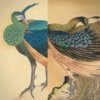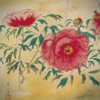Ōhashi Suiseki’s Summary | The Best of Tiger Painters (2/3)

Contents
Debut in the Art World
4th Naikoku Kangyō Hakurankai Exhibition
Ōhashi Suiseki’s debut in the art world was in 1895 ((Meiji 28, 1895), at the age of 31.
He exhibited his work at the fourth Naikoku Kangyō Hakurankai Exhibition, a series of five government-led exhibitions in Japan aimed at fostering export items, for which he received a certificate of merit and a silver medal.
Subsequently, he exhibited at exhibitions in Japan and gradually gained recognition through a series of awards.
The situation in the Japanese art world at the time was as follows.
In 1898, Okakura Tenshin was forced to resign from the Tokyo Art School due to the ‘Art School Riots’, and founded the Japan Art Institute (Nihon Bijutsu-in). This was the beginning of the Nihon Bijutsu-in (Inten Exhibition), which has continued to the present day.
This led to many painters joining the Nihon Bijutsuin (Japan Art Institute), and the Japanese art world became divided into the Old School, centred on the Japan Art Association (formerly the Ryūchikai), the New School, centred on Okakura Tenshin, and a group in between.
It was also around this time that Yokoyama Taikan, Hishida Shunsō and others began to take up the challenge of a new method of expression, namely the fuzzy style.
Highly Rated Worldwide
1900: Paris Exposition
The Paris Exposition of 1900 was a milestone year for the event, and the enthusiasm of France and other countries to exhibit at this World’s Fair was extraordinary.
It was regarded as an important exhibition for Japan to determine whether its own paintings were up to world standards, and preparations were led by the Japan Art Association.
It is thought that political factors played a major role in the selection of works for the jury at this time, mainly by the Japan Art Association rather than the Okakura Tenshin group, which had ousted from public office.
Ōhashi Suiseki, who was not that well-known in the art world at the time, was awarded a gold medal, beating other well-known painters. (Ōhashi Suiseki received a gold medal, Hashimoto Gahō, Kawabata Gyokushō, Imao Keinen and Kuroda Seiki silver medals, Yokoyama Taikan, Takeuchi Seihō and Shimomura Kanzan bronze medals, and Uemura Shōen, Araki Jippo and Wada Eisaku were commended.)
This was the moment when Ōhashi Suiseki’s realistic tiger paintings were recognised worldwide. This established Ōhashi Suiseki as a tiger painter, who subsequently became a focus of attention in the Japanese art world and influenced many other painters.
Interestingly, after the Paris Expo, Takeuchi Seihō stayed in Europe and thoroughly studied Western-style painting. Perhaps partly out of frustration at losing out on the world stage to the then near-unknown Ōhashi Suiseki, Takeuchi Seihō went to the zoo and thoroughly sketched lions, which were difficult to see in Japan at the time, and after returning to Japan he produced a series of large gold screens with lions.
The Paris Expo is of great significance if it is thought that Ōhashi Suiseki had a major influence on Takeuchi Seihō, who is regarded as the twin master of Yokoyama Taikan in the history of modern Japanese painting.










